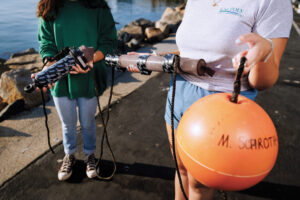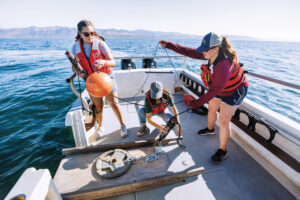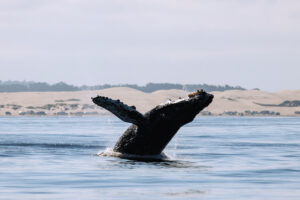The Sounds of the Sea
In their own words, two marine science students describe how they’re using audio data analysis to learn more about our undersea neighbors.

Photos by Joe Johnston
The ocean is a vast environment and an unknown world, where sound is one of the most effective means of communication. In our lab, we are learning how to use those underwater sounds to better understand the vast variety of species that make up our coastal ecosystem.
Bioacoustics is the technique of recording and analyzing the sounds of living creatures for the purpose of monitoring and conservation. For the past few years, we have been working with professor Maddie Schroth-Glanz in the marine bioacoustics lab in the Bailey College of Science and Mathematics on a long-term research project that aims to expand current marine mammal monitoring along Californiaʼs Central Coast. While scientists are doing similar work at marine sanctuaries at the Channel Islands and Monterey Bay, our local coastline has represented a gap in the data — one that we’re working to help fill.

Short, Wilkin and Schroth-Glanz prepare the recording equipment for deployment.
Much of our current work is aimed at better understanding the nature of the soundscape off the coast of San Luis Obispo. Using a custom-designed mooring including a hydrophone that we deploy underwater off the coast every season, we take acoustic data recordings of the animals swimming through the area, visualize the sounds in audio analysis software, and create generalizable data sets that we can learn from.
Determining where the different species are in the water and when, across a variety of deployments and seasons, will help us gain insight into the understudied space between marine sanctuaries. After all, we can only do effective conservation work if we know what exactly we’re conserving. Having this data and making it available is our way of showing the public what’s out there and why it’s worth protecting.
Sophie:
I grew up in Seattle and chose to be a marine science major in part because of my lifelong connection to orcas and other whales in the Pacific Northwest. I grew up whale watching with my dad, and wished for years to get a glimpse beneath the elaborate dances at the surface and learn more about the hidden behavior of whales under the water.
 I’ve always wanted to engage more with marine mammals and conservation efforts, and joined the lab my second year after hearing about the project from Adelle. I dove in head first, contributing as much as I could to the analysis and learning even more about whales from the recordings than I ever thought possible — like the amazing vocal range and unexpected complexity of their songs.
I’ve always wanted to engage more with marine mammals and conservation efforts, and joined the lab my second year after hearing about the project from Adelle. I dove in head first, contributing as much as I could to the analysis and learning even more about whales from the recordings than I ever thought possible — like the amazing vocal range and unexpected complexity of their songs.
One of the big puzzles I’ve been working on solving is identifying a mysterious knocking sound we started hearing last winter. We suspect it might be a group of gray whales that are responsible for the sounds, so part of my work involves figuring out how to detect and analyze those sounds, comparing them to different migration calls, and studying their duration and pulse interval to confirm our suspicions.
My favorite part of being in the lab is being able to engage with that unknown world I’ve loved and been curious about since childhood and getting an opportunity to expand our understanding of the marine environment.
Adelle:
My interest in the ocean originated in watching Blue Planet documentaries and reading field guides as a child, and I first became interested in bioacoustics in high school while writing an essay on the impact of human-made noise on humpback whales. I began working in Maddie’s lab in the summer of 2021 analyzing acoustic data from Monterey Bay for the training of an automatic detector for humpback whales.

A humpback whale breaches off the coast of Oceano in southern SLO County on a recent trip to deploy the team’s audio equipment.
It’s been really exciting to be part of the lab’s evolution — I’ve helped design the mooring we use to secure our equipment to the sea floor, and run testing to prepare for deploying our hydrophone off the coast. I also love working with the data, creating data sets and figuring out which variables will give us the most relevant information as we document the sounds we gather.
So many mammals communicate socially exclusively through vocalizations with the limited visual clarity of the ocean. One of the things I’ve loved about this project is getting to know the unique sounds and voices of the many animals we pick up on our hydrophones. We all know what whales sound like, but have you ever heard the goofy sounds a rockfish makes, or the snapping of a group of shrimp? Sound is truly the key to unlocking the marine environment, and I think it’s so inspiring how bioacoustics gives us a window into that world with limited view, one that is so interconnected with sound.
Click below to hear a sample of the whale vocalizations collected by Sophie and Adelle.


